Marketing automation has changed how I connect with customers and manage campaigns. The best AI tools for marketing automation help me save time by automating repetitive tasks and making smarter decisions using real-time data. These tools can handle things like sending targeted emails, creating content, and analyzing customer behavior without much manual work.
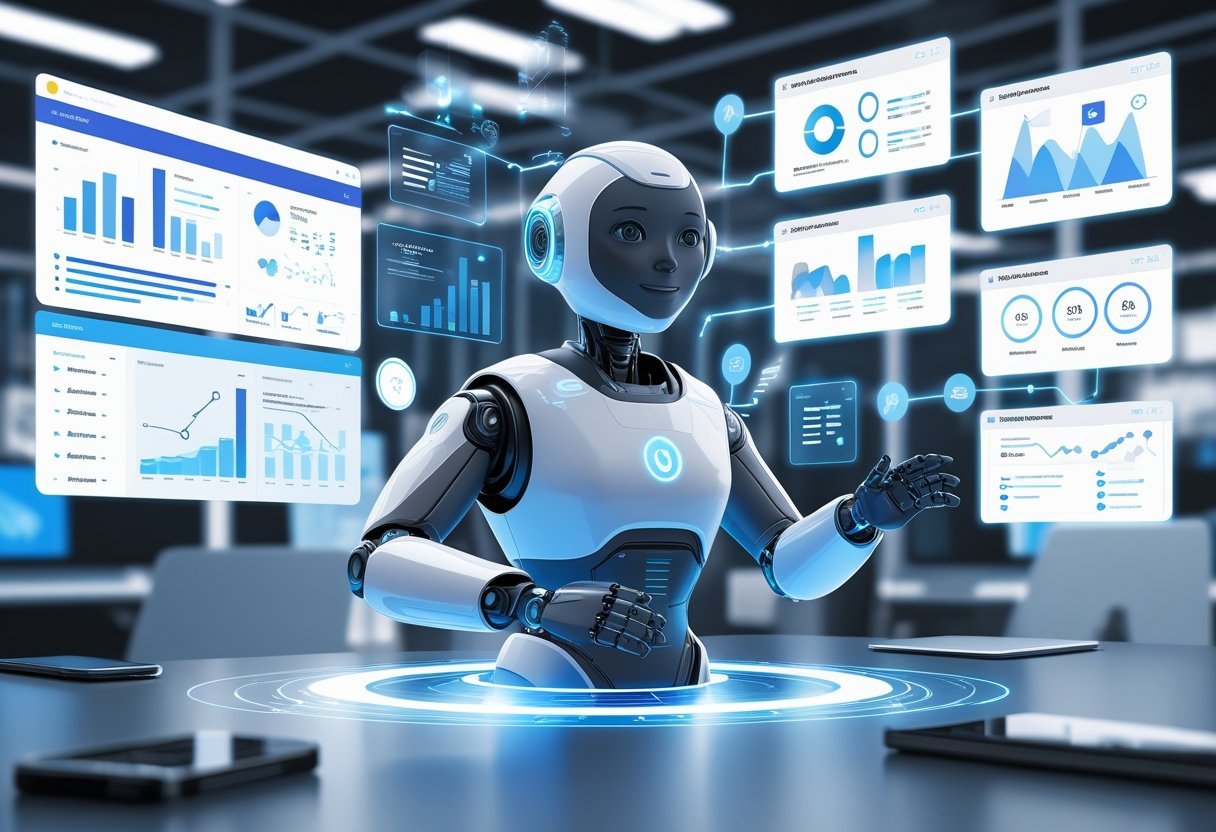
With so many AI-powered options available, it can be hard to know which ones are truly helpful. Some, like Zapier, stand out for AI-driven automation, while Canva and Adobe tools help create content faster. Other platforms use AI to boost productivity, manage leads, and track performance, helping me focus on strategy instead of busywork.
Key Takeaways
- AI marketing automation streamlines daily marketing tasks.
- The right tools provide analytics and boost engagement.
- Choosing top AI solutions can improve results and save time.
What Is AI for Marketing Automation?
AI for marketing automation means using artificial intelligence to help make marketing tasks faster and smarter. These systems can analyze customer data and automate routine activities, like sending emails or posting on social media.
I see artificial intelligence making it easier to reach the right people with the right content. AI-powered marketing uses smart systems to study what customers do, group them into segments, and suggest what content works best.
Some common uses of AI in marketing automation are:
- Predicting customer behavior
- Personalizing emails and messages
- Recommending products or content
- Automating social media posts
- Setting up chatbots to answer questions
AI marketing tools can learn from data and improve over time. This helps me manage marketing campaigns with less manual work and more accuracy.
Many popular AI marketing tools are available to help with these tasks. For example, some tools focus on writing content, while others help with customer segmentation or chatbots.
| Feature | How AI Helps |
|---|---|
| Customer Segmentation | Groups people by behavior |
| Content Personalization | Tailors messages to individuals |
| Campaign Optimization | Picks the best next action |
| Chatbots | Handles simple questions fast |
By using automation and artificial intelligence, I can focus more on important parts of marketing instead of spending time on repetitive tasks.
Key Benefits of AI Marketing Automation
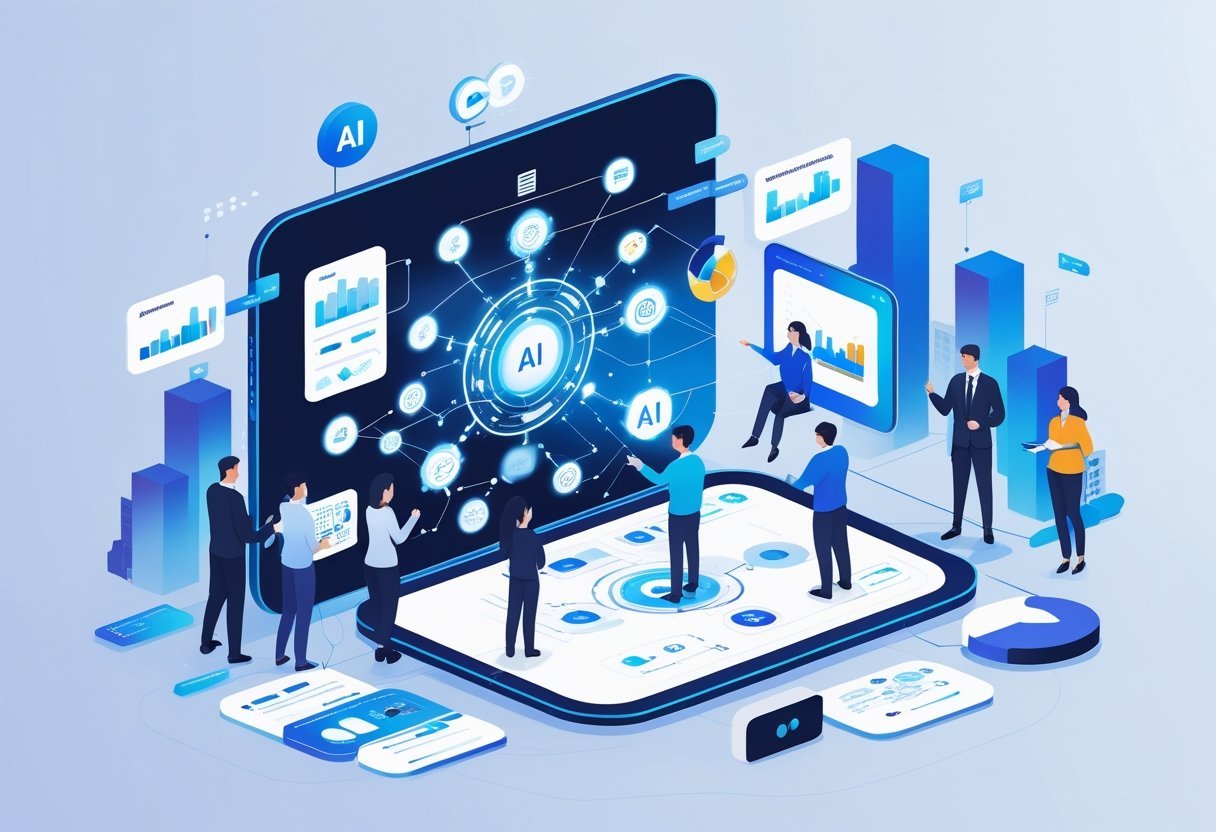
AI marketing automation makes my daily tasks easier, helps me handle bigger campaigns, and lets me use data to make better choices. By using AI, I can save time, reach more people, and improve my results with less effort.
Operational Efficiency
AI in marketing streamlines daily operations by automating repetitive tasks such as email scheduling, customer segmentation, and report generation. When I use automated workflows, I reduce manual work, cut down on errors, and ensure that my campaigns run more smoothly.
I can focus on creative strategy instead of spending hours setting up individual marketing tasks. AI tools also respond faster to new trends, allowing me to adapt my campaigns in real-time. This leads to shorter turnaround times and more consistent results.
Key tasks made more efficient by AI include:
- Automated email marketing
- Social media posting and monitoring
- Ad targeting and budget allocation
These improvements help me work faster and smarter, ensuring that campaigns are always up to date and relevant to my audience. More information can be found on streamlining processes with AI.
Scalability in Marketing Campaigns
AI lets me scale my marketing efforts quickly, so I can reach larger audiences without needing a bigger team. When I use marketing automation, I can manage several campaigns at once. Each campaign can be personalized for different groups of people.
Managing a few hundred customers manually is possible, but managing thousands is not. AI-powered systems handle this growth by automatically adjusting messaging, timing, and targeting across channels. I save both time and resources.
AI also helps reduce costs as campaigns grow. Automated systems handle data entry, customer follow-up, and analytics without extra staff. This lets me invest my team’s energy in tasks that matter most. Agencies, in particular, benefit from AI marketing automation when they need to scale quickly.
Data-Driven Decisions
With AI, I get better insights from large amounts of marketing data. AI-powered systems can analyze patterns in customer behavior, preference, and engagement. This allows me to make smarter, data-driven decisions for each stage of my campaign.
Using AI for analytics and reporting means I don’t have to guess what’s working. The system tells me which content, timing, or channel gives me the best results. For instance, I can see which emails get the most clicks or which ads lead to more sales.
AI also predicts future trends by processing past campaign performance and customer reactions. I can use these insights to improve my strategies, allocate my budget wisely, and create more effective campaigns. For more, AI helps analyze large volumes of data so I can make data-driven choices.
Core Features of the Best AI for Marketing Automation
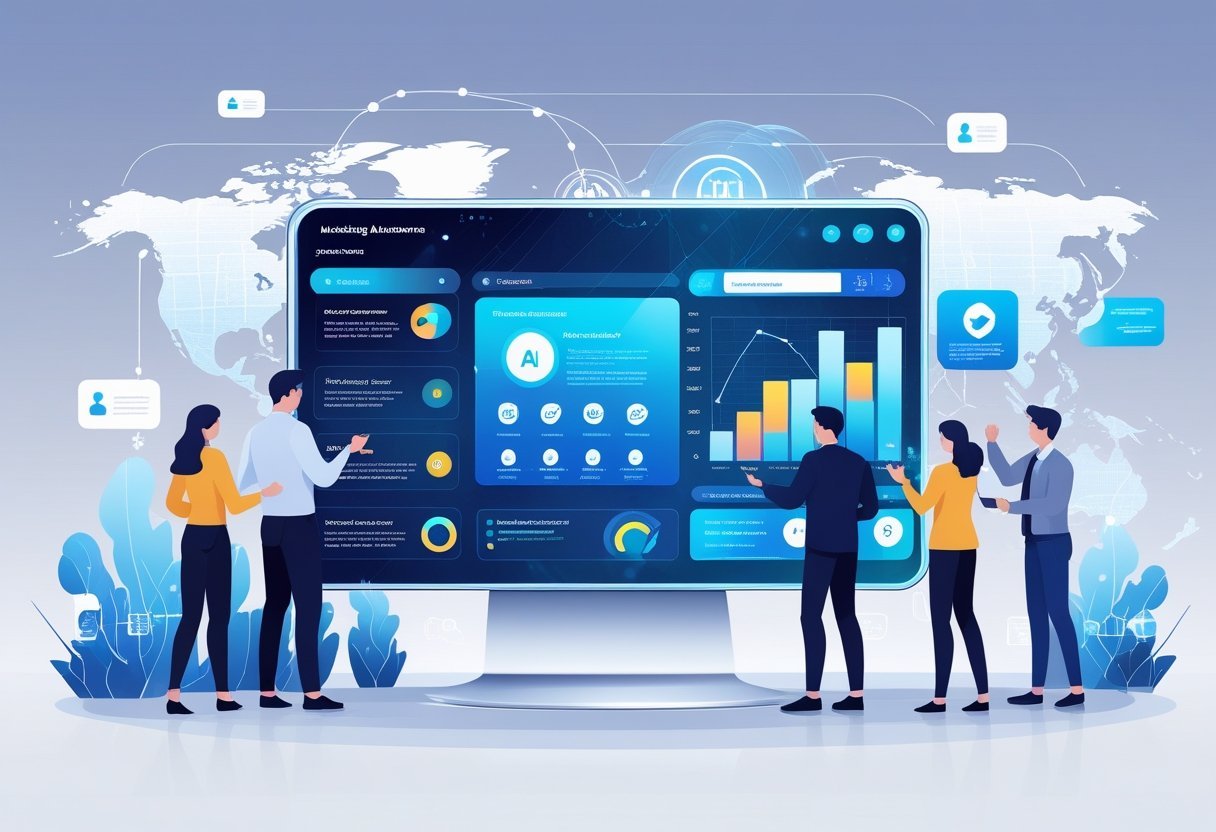
I look for certain features in top AI tools for marketing automation. These features are designed to make campaigns smarter, more efficient, and better at reaching the right audience with the right message.
Personalization
Personalization means showing customers content or offers based on their interests and behavior. I use AI tools to analyze user activity, such as what webpages they visit, purchase history, and even clicks on emails. The best platforms can segment audiences into detailed groups and deliver content that feels unique to each person.
Personalized email subject lines, tailored ads, and dynamic landing pages help increase engagement. Advanced algorithms track customer journeys and adjust messages in real time. Features like AI-driven content recommendations can raise both open and conversion rates for campaigns. This level of personalization makes every interaction more relevant to the customer.
Predictive Analytics
Predictive analytics lets me anticipate future actions using data from past behavior. AI breaks down massive sets of customer data to spot trends and predict who might buy, unsubscribe, or need special attention. It allows me to target campaigns with better timing and improve my return on investment.
For example, I can use AI models that recommend the next-best-action for each customer. These predictions help me design marketing strategies that fit customer needs before they even ask. With predictive analytics, I no longer have to guess what segment or product to focus on—data leads the way.
Automated Workflows
Automated workflows save me time by handling repetitive and manual tasks. I can set up triggers so that certain actions, like sending a welcome email or following up on abandoned carts, happen automatically. These workflows keep leads warm and move them smoothly down the sales funnel.
The top AI tools streamline reporting, content creation, follow-up emails, and other important marketing steps. One example is using AI to draft content, set up drip campaigns, or schedule social media posts. By automating these steps, I can focus on more complex, creative work and leave the routine processes to AI.
Integrations
Integration features connect my marketing automation platform with other tools I use, such as CRMs, analytics, and ad platforms. This unified approach lets data flow smoothly between systems and gives me a full view of customer activity. I can design better campaigns when all my tools work together in real time.
Many AI platforms now come with built-in access to the latest models without the need for complicated setup or extra billing. With integration, I can also connect to third-party apps for advertising, analytics, or lead management through APIs or ready-made connectors. This flexibility helps me expand my strategy and respond quickly to new trends.
Top Use Cases for AI in Marketing Automation
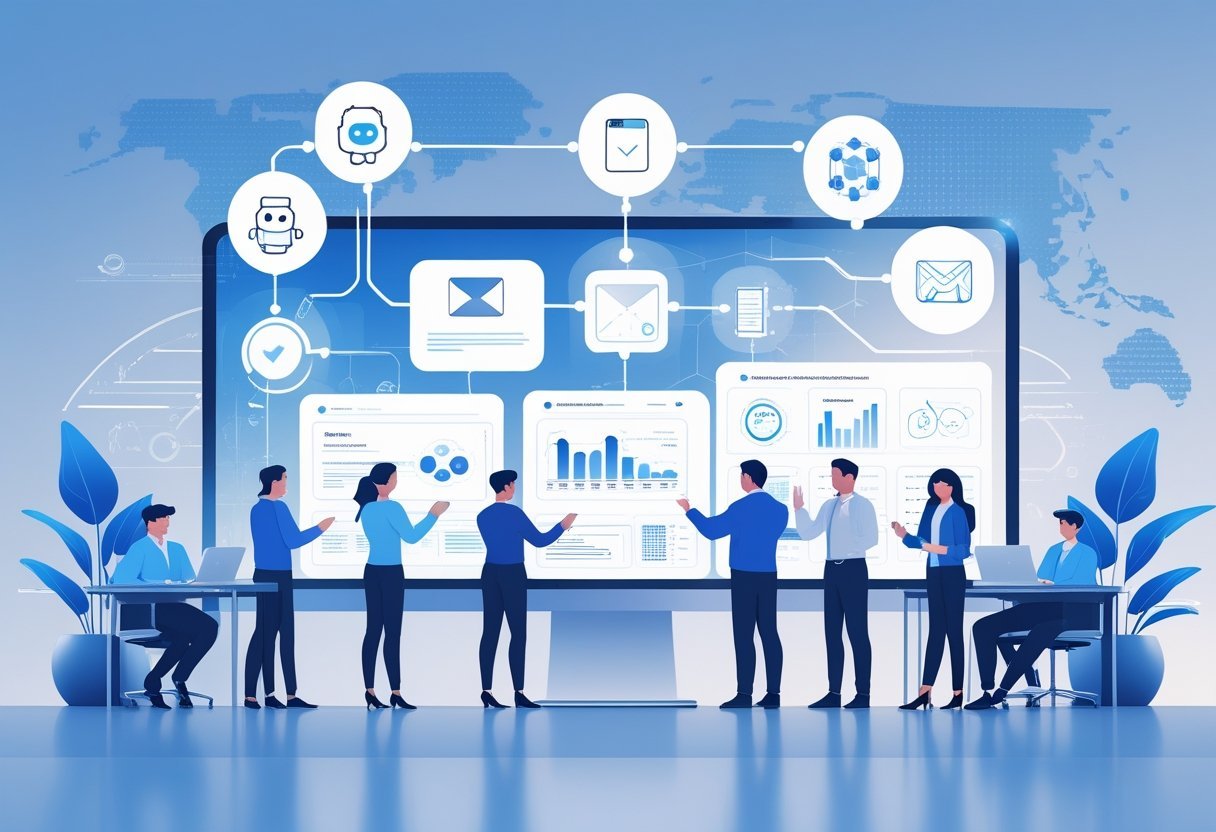
AI improves how I manage and personalize marketing tasks. It helps me save time, target the right audiences, and create messages that better match what each customer wants.
Email Campaign Optimization
When I run email campaigns, I use AI-powered tools to pick the best send times and subject lines. AI looks at when each person is most likely to open emails and adjusts delivery schedules. This helps boost open rates and click rates.
AI also tests different content and layouts through A/B testing. It quickly finds out which message gets the best reactions. With predictive analytics, I’m able to send follow-up emails to people who are more likely to buy or interact.
Using AI, I can also handle list cleaning and filter out inactive contacts. This keeps my email list fresh and helps avoid spam folders. Some advanced AI marketing automation solutions even let me create automated customer journeys, making sure every person gets the right message at the right stage.
Customer Segmentation
I use AI to sort my customers into groups based on interests, purchase history, and behavior. This process, called predictive analytics, allows me to target each segment with messages they actually care about. Good customer segmentation makes campaigns more effective and less likely to be ignored.
AI can track user actions in real time, update segments as people change, and spot trends I might not notice myself. For big email lists or lots of data, AI does the work quickly, which I couldn’t do alone.
By creating better segments, I ensure that each customer gets offers and messages that fit their needs. Top AI tools learn from new data, so my segments constantly improve as more information becomes available. For examples, I rely on platforms highlighted in AI marketing automation guides.
Dynamic Content Creation
AI tools help me build emails, ads, and website content that change based on the reader’s data. For example, if someone recently bought clothes on my site, the next email they get might show matching shoes. This is called dynamic content creation and it is driven by customer preferences.
AI writes product recommendations, subject lines, and even parts of emails for me. Some tools suggest images and layouts based on what has worked best for similar users. This makes each message feel personal without hours of manual work.
When my content feels relevant, I see people click and buy more often. With personalized content and recommendations, I build stronger relationships and keep customers returning.
Omnichannel Engagement
AI helps me connect with customers across many channels, such as email, social media, SMS, and even chatbots. It makes sure each message stays consistent no matter where the customer sees it. This is called omnichannel engagement, and it’s vital to meeting people where they like to interact.
If a customer reads my email and later visits my website, AI can update the messages they see to match their last action. It also helps me send reminders in other channels if someone misses an email.
By tracking each customer across platforms, AI lets me create a smooth experience from the first touch to the final sale. This makes my marketing efforts feel connected and professional, as shown by strong AI marketing use cases in the industry.
AI-Powered Analytics and Reporting in Marketing
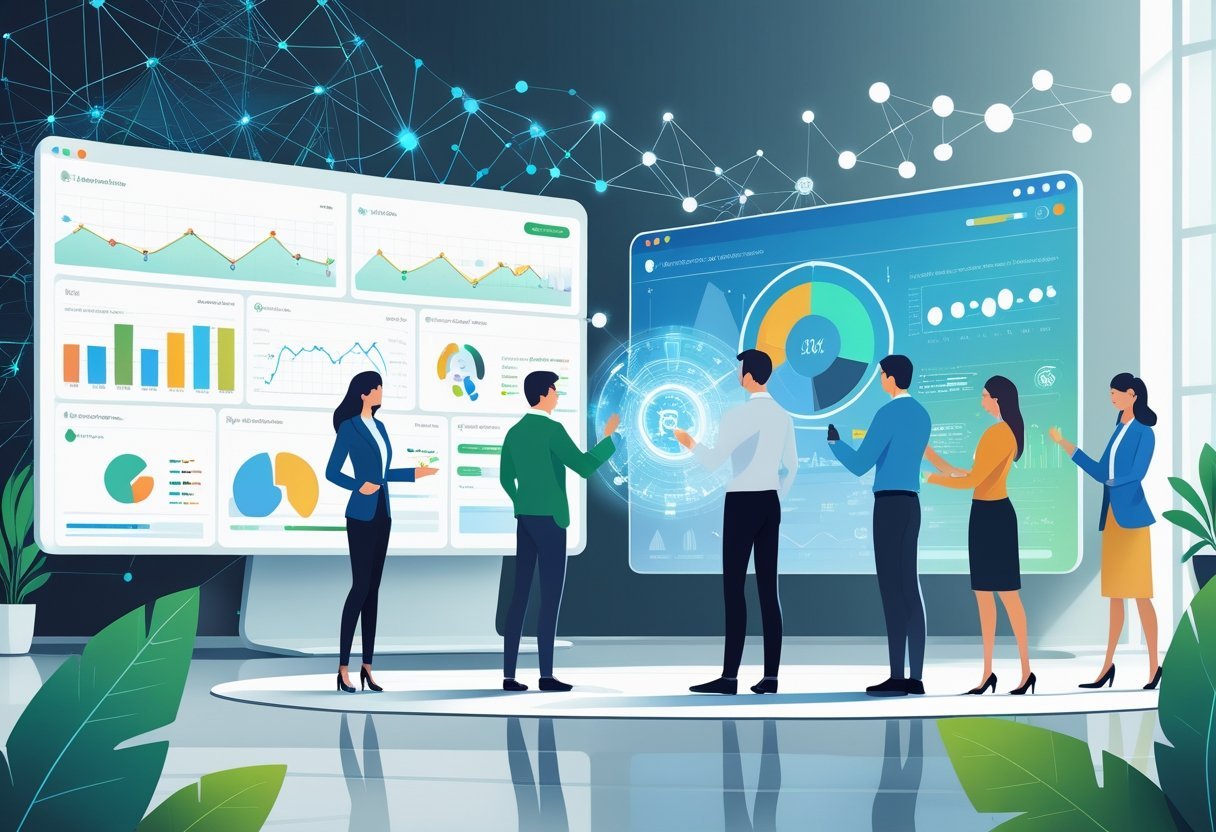
AI in marketing helps me find meaningful patterns in large data sets, automate reporting, and better understand how customers feel and behave. By using these tools, I can make decisions faster and improve marketing strategies over time.
AI-Driven Insights
I use AI to analyze huge amounts of marketing data quickly. These systems help me spot trends in website visits, email campaigns, and social media engagement that I might miss on my own.
AI-powered analytics platforms create visual reports that show key performance indicators (KPIs). This makes it easy for me to track how well my marketing is working each day. Some tools offer recommendations about which content or channel is delivering the best results, so I can shift my budget as needed.
Automated report generation saves me time and helps reduce human error. Many platforms use machine learning to create dashboards, predict future trends, and flag areas that need my attention. For an overview of AI reporting benefits for marketing, I look at tools that provide real-time insights with minimal setup.
Sentiment Analysis
Understanding how customers feel about my brand is critical. AI-powered sentiment analysis reads and processes text from reviews, social posts, and emails to determine if people feel positive, negative, or neutral.
This technology uses natural language processing to scan large amounts of feedback quickly. I rely on it to identify changes in customer mood or public opinion after campaigns or product launches. If sentiment shifts in a negative direction, I can act quickly to solve issues.
Sentiment analysis helps me plan better content by showing which messages encourage positive responses. It also allows me to track how my brand is talked about online, improving my ability to protect my reputation.
Customer Insights
AI helps me understand who my customers are and what they want. By analyzing data such as purchase history, browsing activity, and engagement habits, I get clear profiles of my audience. This is sometimes called advanced analytics.
These systems spot new patterns in customer behavior and highlight important touchpoints in the buying journey. I use this information to personalize offers, predict future needs, and adjust my messaging for each segment.
With AI marketing analytics tools, I am able to create targeted campaigns and measure their impact more accurately, resulting in improved customer satisfaction and better results for my business.
Enhancing Customer Engagement with AI
AI helps me connect with customers in ways that build loyalty and increase satisfaction. By using AI for personalized journeys, chatbots, and service improvements, I make each interaction smoother and more relevant.
Personalized Customer Journeys
When I use AI, I can design personalized customer journeys that adapt to each person’s actions and preferences. AI tools track browsing, buying, and interaction history. Using this data, I send messages and offers that match what a customer is interested in right now.
For example, AI-driven recommendation engines suggest products based on past behavior. This makes each customer feel recognized and valued. AI also controls the timing of messages, sending emails or notifications when people are most likely to respond.
With automation, I create quick paths to move customers through my sales funnel. Personalized journeys also help prevent customers from dropping out by sending reminders or special deals. This leads to higher engagement and stronger brand connections.
To see how companies are using AI for personalization, check out how AI can transform campaigns with tailored content and predictions.
Chatbots for Automated Customer Service
AI-powered chatbots are a core part of my automated customer service strategy. Chatbots answer common questions, handle basic support requests, and guide people to the right resources. They work 24/7, so customers always get fast responses.
I use chatbots to collect information, such as names or order numbers, before connecting someone with a human agent. This saves time for both the customer and my team. Chatbots respond instantly, reducing the time people spend waiting for help.
With natural language processing, these AI systems understand more than just keywords. They can manage full conversations and handle more complex issues than older bots. As a result, customer support becomes more efficient, and customers feel their needs are met quickly.
AI chatbots also collect feedback and report on trends or issues that might need human attention, making my support smarter over time. For a deeper look, Bloomreach explains how AI is changing customer engagement with real-time support.
Improving Customer Satisfaction
To boost customer satisfaction, I rely on AI tools that predict what customers want and quickly solve their problems. AI analyzes feedback, purchase history, and support chats to spot patterns that may impact satisfaction.
I use predictive analytics to act before a customer gets frustrated. For example, if a delivery is late, AI can trigger an apology or update so the customer stays informed. This proactive service builds trust.
AI can also automate follow-ups after support cases close. It checks if the customer was happy and gathers suggestions for improvement. I use that feedback to adjust my processes and offer a better experience next time.
Using AI in marketing automation helps me create a cycle where every interaction is a chance to increase satisfaction and keep customers coming back.
AI Tools Transforming Marketing Automation
AI-powered marketing tools support targeted campaigns, faster workflows, and smarter decision-making. Each platform offers unique features that help me personalize, automate, and analyze marketing tasks.
Albert.ai
Albert.ai uses artificial intelligence to run digital ad campaigns across channels like Google, Facebook, and YouTube. I can use Albert.ai to manage campaigns, analyze data, and optimize budgets in real time. The tool automatically tests creative combinations, selects top-performing ads, and shifts spending for the best return.
I save time because Albert.ai handles the repetitive parts of campaign management for me. It also provides clear insights by tracking performance on each platform. If I want to improve customer targeting and boost ad performance, using Albert.ai is a strong option.
Salesforce
Salesforce is a popular customer relationship management (CRM) solution. Its Marketing Cloud adds AI marketing features called Einstein. With Salesforce, I can segment audiences, automate email campaigns, and predict customer behavior using AI models. The platform uses data from customer profiles, purchase history, and interactions to personalize messages.
Einstein analyzes large amounts of data to find trends, suggest next steps, and forecast results. With automation for tasks like lead scoring and customer journeys, I save time while making each interaction more relevant. Salesforce also connects with many other marketing tools for a smooth workflow. More details are available from the Sprinklr blog.
Zapier
Zapier lets me connect different marketing tools and automate repetitive tasks. It uses “Zaps” to link apps like Gmail, Mailchimp, HubSpot, and Slack. For example, I can automatically add new email subscribers to a CRM or send a message when a form is filled out. There’s no need for coding, so it’s easy for me to set up.
Zapier also supports AI features by integrating with platforms like OpenAI or Google Sheets for smart workflows. I can build custom automations that save time, reduce data entry errors, and keep projects organized. If I use several marketing tools at once, Zapier makes it easier to manage them in one system.
Free AI Tools
Free AI marketing tools let me experiment without a big upfront cost. Many offer basic automation for email, simple chatbots, content creation, or analytics. Some useful examples are HubSpot’s free CRM, Mailchimp’s entry plan, and Google Analytics with AI insights. These help me test different strategies, understand customer data, and automate small tasks.
Free tools usually have limitations on features and usage. As my needs grow, I may need to upgrade for advanced options. However, starting with free AI tools for marketing is a risk-free way to see what works best for my campaigns. I can compare options, learn what fits, and expand as I grow.
Driving Revenue Growth with AI Solutions
AI in marketing automation lets me use data to boost revenue and improve customer engagement. I can tailor marketing strategies, reach the right people, and turn more leads into paying customers.
Conversion Rate Optimization
Using AI-powered tools, I can analyze visitor behavior on my website in real time. This helps me learn what motivates users to click, sign up, or buy.
AI enables predictive analytics, so I see which messages and visuals perform best. I can automatically test headlines, images, and calls to action. This way, I adjust based on what works, not just on guessing.
Some platforms allow me to create personalized user journeys. They’re based on the visitor’s behavior and interests. For example, AI platforms can recommend specific products, send targeted emails, or offer discounts, all designed to push users closer to purchasing.
With these features, I see more leads converting to customers, which drives revenue growth for my business.
Targeting and Retargeting
AI helps me identify the right audiences for my ads or content. With advanced segmentation, I break my customer base into specific groups. I do this based on interests, past purchases, and engagement history.
When someone visits my site but leaves without buying, AI-driven retargeting tools follow up with relevant ads or emails. These reminders encourage people to return and complete their purchase.
I can use lookalike modeling to find new potential customers who resemble my best existing clients. By finding audiences who are more likely to convert, I improve my campaign efficiency and increase my return on investment. These AI-driven targeting features save me time and let me focus on higher-level marketing strategies that help my business grow.
Best Practices for Implementing AI in Marketing Automation
I focus on strategies that support practical use of AI in marketing and help ensure successful adoption. It’s important to pay attention to tool selection and seamless connections with my existing marketing platforms.
Choosing the Right AI Marketing Tools
When I pick AI tools for marketing automation, I first define clear goals. I look at whether I need the AI for tasks like personalized messaging, segmenting customers, predicting behaviors, or managing content.
I check if the tool handles the specific channels I use, such as email, social, or web. Ease of use is a priority, so I review dashboards and reporting features. Data privacy features must meet compliance standards for my industry.
I also compare pricing and long-term value, not just upfront features. I study customer support ratings and software update frequency. For expert tips, I follow advice such as outlining objectives and evaluating data quality.
Key points to assess:
- Channel coverage (email, ads, chatbot)
- Personalization capabilities
- Ease of integration with existing tools
- Security and data privacy tools
- Scalability as my business grows
Integration With Existing Platforms
A smooth integration with my current CRM, e-commerce, and analytics platforms is critical. Before rollout, I review technical documentation and list supported integration partners.
I test the AI tool with sample data to make sure it syncs with customer lists, segments, and reporting. Scheduling regular updates helps avoid broken connections. If the tool supports plug-ins or APIs, I use those for deeper customization.
I encourage my team to attend onboarding sessions so everyone understands how current workflows will change. For more guidance, I explore approaches that stress the need for seamless connections and data flow between platforms.
Steps to ensure smooth integration:
- Map data flows between tools early on
- Set up test environments before full launches
- Create a checklist for tracking key integrations
- Monitor data syncs to catch errors quickly
The Future of AI in Digital Marketing
AI is transforming digital marketing with new trends and technology. I see tools making content creation faster and more personal, with marketing automation saving time on repetitive work.
Emerging Trends in AI Marketing
AI helps me manage social media by scheduling posts and automating replies. With AI, I can track how my marketing channels perform and make quick changes to my strategies. I use data-driven insights to focus on what works best for content marketing and inbound marketing.
Smart automation lets me spend less time on routine tasks and more time creating ideas. As a result, I notice higher engagement on social platforms and more targeted messaging to different customer groups. AI-driven SEO tools also help me improve rankings by suggesting keywords and optimizing my site layout.
Using AI for marketing automation makes work more efficient and boosts results. It helps me balance new technology with human creativity, which is especially important for building a strong brand online. Experts predict that this trend will keep growing, and finding the right mix of automation and creative thinking is key. As AI keeps improving, marketers like me can do more with less effort.
Generative AI for Content Creation
Generative AI lets me create blog posts, ads, and social media content much faster. These tools can write drafts, suggest headlines, and even design images, saving me hours every week. I use them to generate new ideas or freshen up my content marketing strategy.
Quality is a big focus. I always review and edit the AI’s suggestions to match my brand’s style. Using AI for content creation means I can produce more relevant posts for my audience and keep up with fast changes in digital marketing.
For social media marketing, generative AI helps me tailor posts for each channel. It can schedule when to publish, recommend tags, and suggest topics that connect with followers. These tools also support SEO by optimizing content for search engines, making it easier for people to find my posts. I rely on generative AI as part of my toolkit, balancing its power with my own creativity to stay ahead in digital marketing.
Frequently Asked Questions
AI has changed how I manage marketing tasks like campaign creation, customer targeting, and content planning. Leading tools offer advanced features that support both small teams and large marketing departments.
Which AI marketing tools lead in terms of integration and ease of use?
Some AI marketing tools offer strong integration options and simple interfaces. For example, platforms like ChatGPT and Zapier are popular for marketing automation, making it easy to connect with other services and create automated workflows. These tools help me save time and reduce manual work. Learn more about common AI marketing tools and their benefits at this AI marketing FAQ guide.
What are the top free AI tools available for enhancing marketing efforts?
There are several free AI tools that help me boost my marketing efforts. Many offer basic versions with important features, like content creation, analytics, and campaign scheduling. Some popular free options include limited versions of ChatGPT and Zapier. These tools help bridge gaps where paid tools can be out of budget.
How do AI platforms improve customer engagement in marketing campaigns?
AI platforms allow me to deliver more personalized messages and product recommendations by analyzing customer data and behavior. They can send the right content at the right time, which often leads to better open rates and more engagement. AI also helps track and respond to user activity quickly.
What are the advantages of using a specialized AI marketing agency?
Specialized AI marketing agencies give me access to expert support, advanced technology, and tailored solutions. These agencies can build custom strategies and handle complex data analysis, which is helpful when I need results that go beyond general marketing tools. Their experience can also reduce the risks of using new technologies.
How can AI contribute to the automation and personalization of email marketing?
AI makes it possible for me to automate email campaigns so they go out based on user behavior instead of a set schedule. It can also personalize email subject lines, body content, and product suggestions, leading to higher open and click rates. This means each subscriber can receive emails that are more relevant to their needs.
In what ways can AI be utilized to optimize content marketing strategies?
AI tools can help analyze which topics perform best and suggest new content ideas based on user interests. They also help me create SEO-friendly articles, generate visuals, and schedule posts for maximum impact. Platforms like Midjourney and ChatGPT are examples of tools that support AI-driven content strategies, as explained in this AI marketing tool overview.



